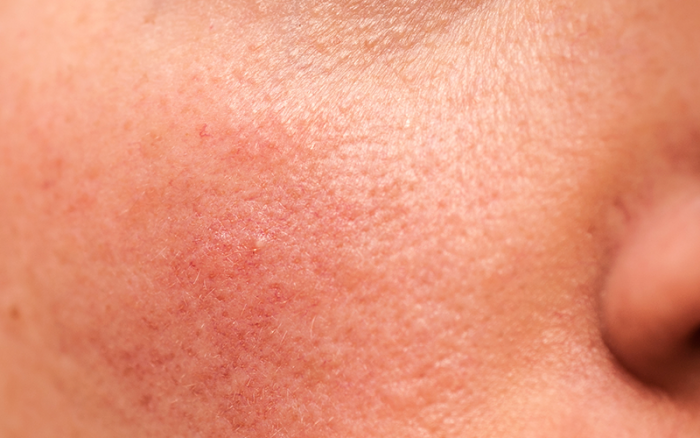Rosacea affects millions of men and women in the U.S., and symptoms come in many forms, ranging from mild redness and flushing of the face, forehead, nose, and cheeks to acne breakouts, constant redness and even a thickening of the skin.
Typically, rosacea symptoms come and go in “flares,” appearing and disappearing for up to several weeks at a time. Controlling these flare-ups begins with understanding your rosacea triggers. Exercise, sun exposure, extreme weather or even stress have been known to cause rosacea flare-ups. Many times, certain foods can also play a role. Here are some of the common foods that have been known to trigger rosacea flare-ups:
Spicy (and Thermally Hot) Foods
Spicy and “hot” foods can cause you to sweat, which can, in turn, cause flushing, and rosacea flare-ups in some people. These common rosacea triggers include foods such as hot peppers, hot sauce, horseradish, curry, chili, salsa, hot sausage, Cajun-style foods and other foods with “hot” spices such as white and black pepper, paprika, and red and cayenne pepper.
Hot Beverages
Sometimes, hot beverages such as tea, hot chocolate, hot cider, and coffee can cause flushing and trigger rosacea flare-ups. Though coffee and caffeine are often blamed for triggering a flare-up, research shows it is actually the thermal heat of beverages that is a rosacea trigger rather than the coffee or caffeine itself. Letting hot drinks cool to a lukewarm temperature before drinking, reducing the number of servings or switching to a cold version of your favorite hot drinks can help ease rosacea symptoms.
Alcohol
Alcohol affects everyone differently, but it has been known to induce flare-ups in some people with rosacea — especially red and white wines. Patients have also reported experiencing rosacea symptoms after drinking beer, champagne, vodka, tequila, bourbon, gin, rum, and scotch. That said, despite popular belief, excessive alcohol consumption does not cause rosacea.
If you notice that alcohol is a rosacea trigger for you or aggravates your symptoms, reduce your alcohol intake or avoid it altogether. Many patients report that reducing their alcohol consumption has helped limit flare-ups.
According to the National Rosacea Society, other foods that may trigger rosacea flare-ups include: liver, yogurt, sour cream, cheese (except cottage cheese), chocolate, vanilla, soy sauce, yeast extract (bread is OK), vinegar, eggplant, avocados, spinach, broad-leaf beans and pods including lima, navy or pea, citrus fruits, tomatoes and bananas, red plums, raisins, figs and foods high in histamine.
In some cases, taking an antihistamine about two hours before a meal may counter the effects of histamine. Aspirin can also reduce the effects of niacin-containing foods.
Best Treatment Options for Rosacea
Typically, rosacea begins as redness or flushing on the cheeks, nose, chin or forehead that can come and go, eventually leading to the appearance of small dilated blood vessels. In some severe cases, bumps and pimples appear and the nose can become swollen.
“Because rosacea can be progressive, it is important to get an accurate diagnosis and seek treatment as soon as you start to see symptoms,” says Dr. Roopal Bhatt, a board-certified dermatologist with U.S. Dermatology Partners Mueller.
While there is no cure for rosacea, there are treatment options that will improve your symptoms and prevent long-term damage to your skin.
Switching out your skin care products to milder, more gentle cleaners and rinsing your face with lukewarm instead of hot water can soothe aggravated skin during a flare-up, as does avoiding skin care products with alcohol or harsh astringents. Remember to dress appropriately for extreme weather, manage your stress, limit sun exposure and always wear sunscreen with an SPF of at least 30 along with a wide-brimmed hat and sunglasses to protect your face and eyes.
In addition to these simple lifestyle changes, laser rosacea therapy can help reduce intense redness caused by broken blood vessels. A pulsed dye laser (PDL) targets visible blood vessels to reduce redness and flushing by destroying the lining of the inflamed blood vessels.
For milder rosacea that causes small, acne-like bumps on the skin, oral and topical medications can be used to control flare-ups. Topical gels can also reduce the appearance of bumps and redness and help to constrict blood vessels in your face. Oral antibiotics can also be used to reduce skin inflammation in some cases.
“There is a wide range of rosacea symptoms and also a wide range of rosacea triggers,” says Dr. Bhatt. “To help determine what triggers your flare-ups, track your activities, the products you use, and the foods you eat that may contribute to a flare-up and then work to avoid them.”
Looking to Visit a Dermatologist for Rosacea?
To discuss treatment options for your rosacea or for help identifying your rosacea triggers, make an appointment with one of U.S. Dermatology Partners’ board-certified dermatologists today to find a treatment plan that works for you. We have multiple locations throughout the country, so fill out our simple online form to get in touch with us. One of our local team members will reach out to you shortly to answer your questions or schedule an appointment for you to visit us soon.
Find a location near me
or

